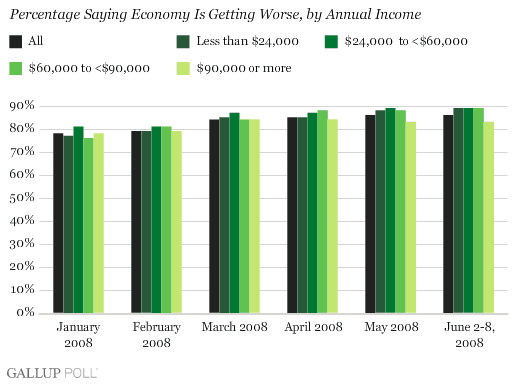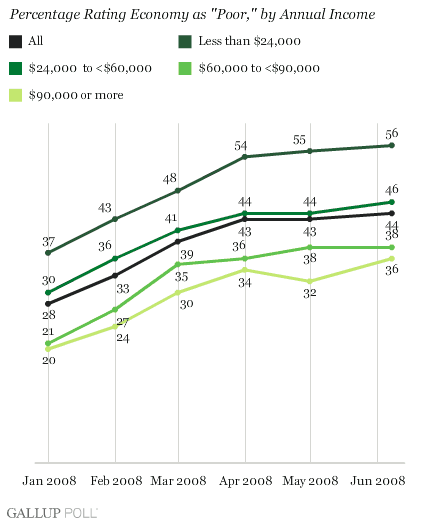PRINCETON, NJ -- The percentage of Americans saying the U.S. economy is going in the wrong direction remained at 86% in early June -- the same as in May -- and that degree of pessimism included Americans across the income spectrum, as even 83% of those making $90,000 a year or more said the economy is getting worse, not better.

Economy Going in Wrong Direction
Late Monday, Federal Reserve Board Chairman Ben Bernanke raised fears on Wall Street that the Fed may end up raising interest rates in the months ahead, in an effort to keep inflation from getting out of hand -- noting that the risk of a substantial economic downturn has receded over the past month. Bernanke's comments, along with those of other Fed governors, seemed designed to position monetary policymakers as ready to combat inflation and thereby support the U.S. dollar.
Although Treasury Secretary Henry Paulson asserted earlier Tuesday that the declining value of the U.S. dollar is not causing higher oil prices, it is theoretically possible that higher interest rates and a stronger dollar may help lower oil and other global commodity prices, providing all the attendant consumer benefits. On the other hand, no one could blame the average American for wondering whether Bernanke's move from an academic "ivory tower" to that of the Fed might simply mean he is even more removed from the everyday realities of Main Street, U.S.A.
In sharp contrast to Bernanke's view, Americans show near-unanimity in their perceptions that the economy is getting worse, not better. During the first week of June, 89% of those making less than $24,000 a year said the economy is getting worse -- identical to the percentage holding this view among those making $24,000 to less than $60,000, and $60,000 to less than $90,000. Even among those making $90,000 or more, 83% say the U.S. economy is continuing to deteriorate -- not get better.
While this degree of consumer pessimism regarding the current direction of the U.S. economy has increased significantly among consumers of all income levels since January, current consumer perceptions remain essentially unchanged compared to those of May. Of course, this may be due to something of a "ceiling effect" because most of the percentages involved approach 90%.
Many Consumers Continue to Rate Economy as "Poor"
The percentage of Americans rating the economy as "poor" remained at 44% in early June -- essentially the same as in May (43%) and April (43%). And there continues to be a significant difference by income in how people rate the economy, in contrast to the "getting worse" numbers.
During the first week of June, 56% of those making less than $24,000 a year rated current economic conditions as poor. At the same time, 46% of those making $24,000 to less than $60,000 a year gave that rating, as did 38% of those making $60,000 to less than $90,000, and 36% of those making at least $90,000.

Can the Economy Avoid a Significant Downturn With Consumers So Pessimistic?
On Friday, the University of Michigan will release its preliminary findings on its Consumer Sentiment Index for June. Assuming this much smaller survey aligns with Gallup's findings, as it usually does, consumer sentiment should show essentially no change in early June.
However, this does not necessarily confirm Bernanke's assertion that the risk of a significant economic downturn receded last month. That may be the case as far as the financial sector is concerned, although that still seems somewhat unclear. What does seem clear, based on Gallup's results, is that Americans overwhelmingly agree that the current economy is getting worse, not better.
Survey Methods
Gallup is interviewing no fewer than 1,000 U.S. adults nationwide each day during 2008. The economic questions analyzed in this report are asked of a random half-sample of respondents each day.
The results reported here are based on combined data of more than 3,000 interviews conducted during the week of June 2-6, 2008. For results based on this sample, the maximum margin of sampling error is ±2 percentage points.
Other results are based on combined data of more than 8,000 interviews in January, February, March, April, and May. For results based on these samples, the maximum margin of sampling error is ±1 percentage point.
Interviews are conducted with respondents on land-line telephones (for respondents with a land-line telephone) and cellular phones (for respondents who are cell-phone only).
In addition to sampling error, question wording and practical difficulties in conducting surveys can introduce error or bias into the findings of public opinion polls.
To provide feedback or suggestions about how to improve Gallup.com, please e-mail feedback@gallup.com.
